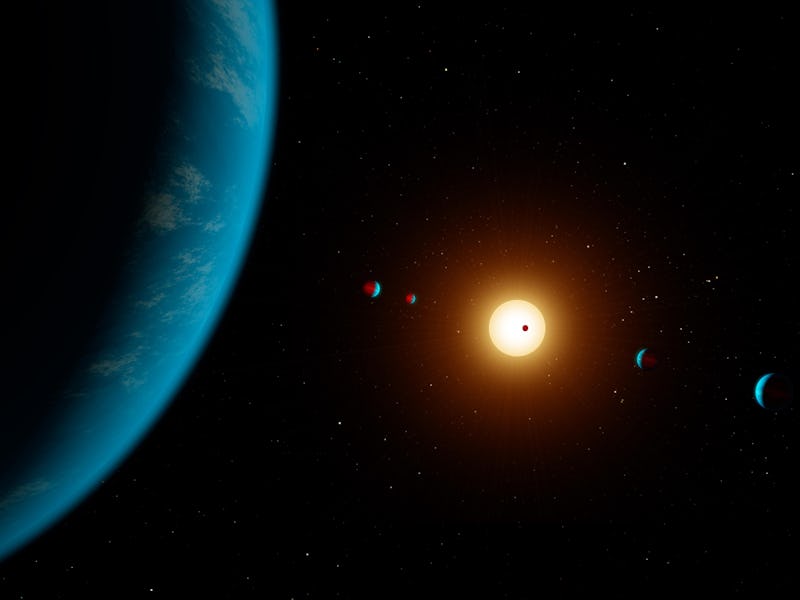Scientists pinpoint how many planets in the Milky Way could host life
The odds are in our favor.

The Milky Way contains at least 100 billion planets. And scientists are hell-bent on finding which ones might harbor life.
Our galactic neighborhood may be bustling with other worlds, but a new study estimates that a mere 300 million of those 100 billion planets may have the right ingredients for life.
And some of them may be closer than we think.
The study, published on preprint server ArXiv and accepted for publication in The Astronomical Journal, provides perhaps the most reliable estimate of habitability in our galaxy to date
Exoplanets come in all shapes and sizes, but only a few may be habitable.
Previous guesses at how much of the Milky Way may be habitable have ranged between as much as 40 billion and as low as six billion planets.
But by using data from exoplanet hunting missions such as Kepler and Gaia, the researchers behind the new study claim that their estimate is much more accurate.
“This is the first time that all of the pieces have been put together to provide a reliable measurement of the number of potentially habitable planets in the galaxy,” Jeff Coughlin, an exoplanet researcher at the SETI Institute and Director of Kepler’s Science Office, and co-author of the new study, said in a statement.
The astronomers homed in on three main determinants for habitability. First, they estimated the number of exoplanets similar in size to Earth in the Milky Way — these are most likely to be rocky planets. Then, they looked at how many stars are similar in age and temperature to our Sun. Lastly, they considered whether the planets have the conditions necessary to support liquid water, a critical ingredient for life.
Older studies only considered the distance of a planet from its host star to calculate habitability — a gross measure, the new study suggests. Instead, this research also takes into account how much light a planet would receive from its star based on more than mere distance alone. NASA's Kepler mission zoomed in on stars to see if there are planets orbiting within their habitable zone. Meanwhile, the European Space Agency's Gaia mission measured the positions, distances, and motions of stars to get a more definitive estimate of how much light — and thus, heat — they bestow on their planets.
The study found that there could be 300 million habitable planets in the Milky Way. Some are just 30 light years from the Sun, the data suggest.
Scientists have confirmed the existence of more than 4,000 exoplanets, although 3,000 more suspected exoplanets are awaiting confirmation. Some of these planets have shown signs of potential habitability, but whether they do host life will be extremely difficult to determine.
“Knowing how common different kinds of planets are is extremely valuable for the design of upcoming exoplanet-finding missions,” Michelle Kunimoto, member of the Transiting Exoplanet Survey Satellite team at the Massachusetts Institute of Technology and co-author of the new study, said in a statement. “Surveys aimed at small, potentially habitable planets around Sun-like stars will depend on results like these to maximize their chance of success.”
Abstract: We present occurrence rates for rocky planets in the habitable zones (HZ) of main-sequence dwarf stars based on the Kepler DR25 planet candidate catalog and Gaia-based stellar properties. We provide the first analysis in terms of star-dependent instellation flux, which allows us to track HZ planets. We define η⊕ as the HZ occurrence of planets with radius between 0.5 and 1.5 R⊕ orbiting stars with effective temperatures between 4800 K and 6300 K. We find that η⊕ for the conservative HZ is between 0.37+0.48−0.21 (errors reflect 68\% credible intervals) and 0.60+0.90−0.36 planets per star, while the optimistic HZ occurrence is between 0.58+0.73−0.33 and 0.88+1.28−0.51 planets per star. These bounds reflect two extreme assumptions about the extrapolation of completeness beyond orbital periods where DR25 completeness data are available. The large uncertainties are due to the small number of detected small HZ planets. We find similar occurrence rates using both a Poisson likelihood Bayesian analysis and Approximate Bayesian Computation. Our results are corrected for catalog completeness and reliability. Both completeness and the planet occurrence rate are dependent on stellar effective temperature. We also present occurrence rates for various stellar populations and planet size ranges. We estimate with 95% confidence that, on average, the nearest HZ planet around G and K dwarfs is about 6 pc away, and there are about 4 HZ rocky planets around G and K dwarfs within 10 pc of the Sun.